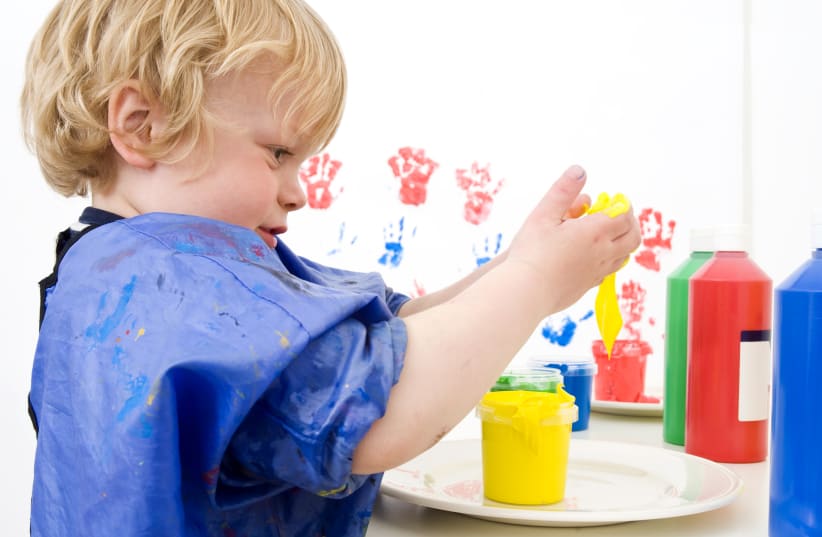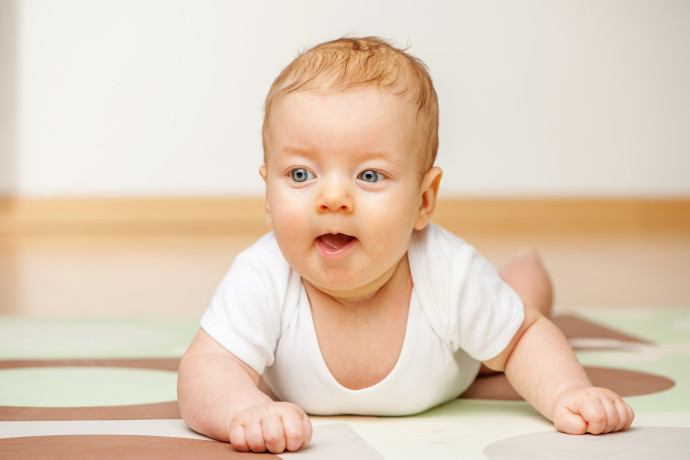So many games and toys are sold in various stores, classified according to age-based skill sets and interests. But sometimes the best, least expensive solution is right under your nose, and in this case in your own home.
You don’t have to be really creative to make toys and games for your baby, but simply invest a little time to create experiences and enjoy the creative process for yourself.
So what things can you DIY for your baby?
Shlomit Schuster, an infant development specialist, family counselor, developmental stages guide and infant massage practitioner, has some ideas:
DIY activity surface, from when babies start lying on your stomach.
Buy a plastic bag that seals with a strong vacuum at a craft or housewares store, put some water in it and add a little blue paint. Then, cut out stencils of fish of different colors, cuttings of circles and balls (not small enough to swallow) and put these inside. Seal the bag and place it on the floor. Put baby next to it, allow the baby to press on it. He/she will enjoy the colors and how the bag moves slightly when the surface is pressed down.
Ball and water mold: great for when baby has tummy time.
It’s easy and enjoyable for babies to stay on their backs, but tummy time is crucial for developing neck muscles. Babies also learn to track movement with their eyes when they’re on their stomachs. To keep babies from flipping to their backs, they need a variety of interesting activities to stimulate them. This activity is suitable for hot days. Take a mold, fill it with water, put balls (again, not too small) with different textures in it. Put the baby near it to enjoy the feelings and touch. When the baby can lift the head and stabilize, he/she will reach for the balls.
A homemade toy encourages crawling, and from six months, it’s never too early to help a baby start developing this skill.
Rinse a clear plastic bottle, remove the outer sticker and fill half of its contents with water. Now take a bag of glitter that can be found in any craft store. Put the glitter inside the bottle with the water and close it tightly. For extra safety, use hot glue to seal the cork. Shake the bottle and lay it on a surface, with the child lying on his stomach and the toy at eye level. The colored bottle will encourage tummy time, as the baby will be fascinated by the colors and the sparkles flying around. When the bottle is touched it will move away, but not very much. This will encourage the baby to try to get closer and get to the bottle without creating frustration.
Hand paints for when a child can sit.
Take these ingredients:> Half a cup of white flour> Three glasses of water> Three tablespoons corn flour dissolved in a quarter cup of water> A teaspoon of food coloring
Use food coloring, not paint, since babies learn through taste and put everything into their mouths.
Instructions:
Mix flour and water in a pot over a low flame, stirring constantly until the water is almost boiling. Add corn flour dissolved in water and continue to stir until the dough is uniform. After it cools, divide into several bowls and add a teaspoon of a different food coloring into each one. Now, sit the baby on your lap next to the table. In order to keep it clean, spread a disposable tablecloth, place the plate with the dough in front of the baby and give the baby a small amount so that it can be felt with both hands. In the summer, undress the baby and let him or her move around while playing with the material, which is great for developing all the senses: sight, hearing, smell, taste but especially tactile touch.
In addition, playdough also contributes to these areas:
> Fine motor skills - strengthening arm muscles as fingers knead, dribble and roll.
> Gross motor skills - strengthening large body muscles.
> Sensory regulation - contact and familiarity with different textures and materials.
> Emotional development - a time of fun, enjoyment and relaxation.
Wire pull box for around seven to eight months.
The motor development skills of babies at this stage will let them pull things and have lots of fun. Take a small box, make holes in it and thread strings of different colors and textures through them. Tie the threads on the inside of the box and give the baby the option to pull them from the outside. Encourage your baby to pull once with his right hand and once with his left hand. This activity really delights babies and will be a favorite.
*Remember to supervise babies during all of these activities.

